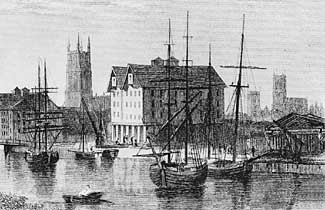 The
Canal Frontage The
Canal Frontage
Following the opening of the canal, the development potential of
the field known as High Orchard was recognised by Samuel Baker and
Thomas Phillpotts, who built a quay wall along the canal frontage
and then leased or sold off plots of land to local merchants. For
more about the partners and how they had benefited from owning slaves
in Jamaica, follow this link.
The northern end of the quay was initially
occupied by timber yards and a pair of semi-detached corn warehouses
(now Pillar & Lucy House). A plot near the southern end was
sold to the Birmingham & Gloucester Railway Co, and this later
became the High Orchard Yard of the Midland Railway Co, initially
with its own branch dock off the canal. The southernmost plot was
sold to the Anti Dry Rot Co who set up a works to manufacture corrosive
sublimate (mercuric chloride) used in a treatment for preserving
timber.
Victorian Industries
The
land behind the canal-side timber yards provided ideal sites for
new industries, together with housing for the workers, shops, half-a-dozen
pubs and St Luke's church. In the 1840s, Price & Co built a
steam saw mill, Charles Jones established a sail loft and James
Brimmell set up a rope walk along the southern boundary of High
Orchard. In the 1850s, further plots were taken up for the High
Orchard iron works, John Cale's enamelled slate works and another
saw mill started by Samuel Moreland (who later became famous for
making matches). In the 1860s, Foster Brothers established an oil
and cake mill on the site of the former Anti Dry Rot Works, Fielding
and Platt developed the Atlas Ironworks and Belcher Gee & Co
started another enamelled slate works. In the 1870s, the brothers
G & W E Downing set up a malthouse, adding others in later years,
and Collett & Co established a works for manufacturing chemicals.
In the 1880s, King & Co opened a confectionery factory, and
in the 1890s J A Matthews & Co established a huge furniture
factory, the former sail loft was converted to a corn mill and J
Sessions & Sons opened a large enamelled slate works.
 Twentieth Century Industries Twentieth Century Industries
By the beginning of the twentieth
century, the former orchard had become largely covered by buildings,
including some built on the former timber yards. Two of the main
businesses were Fielding & Platt's Atlas engineering works,
which later expanded to take over the site of St Luke's church,
and Matthew's cabinet works on either side of High Orchard St. After
the latter closed in 1935, part of the premises was occupied by
the Gloucester Carpet Co.
Other
significant employers were Foster Brothers oil and cake mill, Downing's
malthouses and Sessions enamelled state works, all on Bakers Quay,
and the High Orchard iron works in Baker St. All of these were served
by sidings from the Midland Railway Co's High Orchard goods yard.
Over the years, however, these old industries found it increasingly
difficult to compete with businesses elsewhere, and one by one they
closed down.
Regeneration
In recent
years, the High Orchard area has become the site for the Gloucester
Quays designer outlet shopping centre. Most of the former industrial
buildings have been swept away, but some have been incorporated
into the new centre.
For further information, see: Foster
Bros Oil & Cake Mill, Downings
Malthouses, Outlet
Centre Progress
Sources: TNA RAIL 829 minute books; Glos Arch D3117/2536-40;
IN 11 Industrial Gloucestershire; Rate books; Suppl 56th Rep Chamb
of Commerce; OS maps; trade directories. |
 The
Canal Frontage
The
Canal Frontage Twentieth Century Industries
Twentieth Century Industries